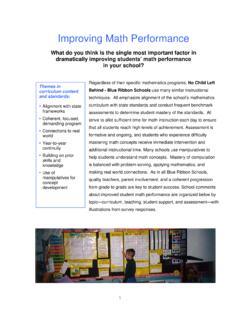Transcription of AN4841 Application note - STMicroelectronics
1 February 2018AN4841 Rev 21/251AN4841 Application noteDigital signal processing for STM32 microcontrollers using CMSIS IntroductionThis Application note describes the development of digital filters for analog signals, and the transformations between time and frequency domains. The examples discussed in this document include a low-pass and a high-pass FIR filter, as well as Fourier fast transforms with floating and fixed point at different associated firmware (X-CUBE-DSPDEMO), applicable to STM32F429xx and STM32F746xx MCUs, can be adapted to any STM32 Signal Processing (DSP) is the mathematical manipulation and processing of signals.
2 Signals to be processed come in various physical formats that include audio, video or any analog signal that carries information, such as the output signal of a Cortex -M4-based STM32F4 Series and Cortex -M7-based STM32F7 Series provide instructions for signal processing, and support advanced SIMD (Single Instruction Multi Data) and Single cycle MAC (Multiply and Accumulate) use of STM32 MCUs in a real-time DSP Application not only reduces cost, but also reduces the overall power following documents are considered as references: PM0214, STM32F3 and STM32F4 Series Cortex -M4 programming manual , available on PM0253, STM32F7 Series Cortex -M7 programming manual , available on CMSIS - Cortex Microcontroller Software Interface Standard, available on Arm compiler toolchain Compiler reference, available on Developing Optimized Signal Processing Software on the Cortex -M4 Processor , technical paper by Shyam Sadasivan, available on Rev 2 Contents1 Basic DSP notions.
3 Types .. point .. point .. vs. floating-point .. 72 Cortex DSP instructions .. instructions .. instructions .. instructions .. 83 Algorithms .. 104 DSP Application development .. library .. demonstration overview .. demonstration .. performance .. filter demonstration .. filter design specification .. performance .. example software overview .. of STM32 product lines performance .. 225 Revision history .. 24AN4841 Rev 23/25AN4841 List of tables3 List of tablesTable and cons of number formats in DSP applications .
4 7 Table instructions .. 8 Table instructions .. 9 Table filter specifications .. 17 Table performance .. 23 Table history .. 24 List of figuresAN48414/25AN4841 Rev 2 List of figuresFigure precision number format .. 5 Figure precision number format.. 5 Figure bits fixed point number format .. 6 Figure size calculation performance on STM32F429 .. 13 Figure size calculation performance on STM32F746 .. 13 Figure FFT 1024 points with input data in Float-32 on STM32F429I-DISCO .. 14 Figure FFT 1024 points with input data in Float-32 on STM32F746-DISCO.
5 15 Figure diagram of the FIR example .. 15 Figure input (sum of two sine waves) .. 16 Figure spectrum of the input signal .. 17 Figure filter verification using MATLAB FVT tool .. 19 Figure filter computation performance for STM32F429.. 20 Figure filter computation performance for STM32F746.. 20 Figure demonstration results on STM32F429I-DISCO .. 21 Figure demonstration results on STM32F746-DISCO .. 21AN4841 Rev 25/25AN4841 Basic DSP notions241 Basic DSP Data typesDSP operations can use either floating-point or fixed-point Floating pointFloating point is a method to represent real floating point unit in the Cortex -M4 is only single precision, as it includes an 8-bit exponent field and a 23-bit fraction, for a total of 32 bits (see Figure 1).
6 The floating point unit in the Cortex -M7 supports both single and double precision, as indicated in Figure representation of single/double precision floating-point number is, respectivelyValue = (-1)s x M x 2(E-127), or Value = (-1)s x M x 2(E-1023)where S is the value of the sign bit, M is the value of the mantissa, and E is the value of the 1. Single precision number formatFigure 2. Double precision number format06 9 ELWV0 DQWLVVD ELWV ([SRQHQW ELWV 6 LJQ ELW 06 9 ELWV0 DQWLVVD ELWV ([SRQHQW ELWV 6 LJQ ELW Basic DSP notionsAN48416/25AN4841 Rev Fixed pointFixed point representation expresses numbers with an integer part and a fractional part, in a 2-complement format.))]]
7 As an example, a 32-bit fixed point representation, shown in Figure 3, allocates 24 bits for the integer part and 8 bits for the fractional 3. 32 bits fixed point number formatAvailable fixed-point data sizes in Cortex -Mx cores are 8-, 16- and most common format used for DSP operations are Q7, Q15 and Q31, with only fractional bits to represent numbers between and + representation of a Q15 number is:Value1 ()bsb1421 b1322 ..b1214 b0215 ++++() =where bs is the sign bit (the 15th bit), and bn is the digit for bit range of numbers supported in a Q15 number is comprised between and , corresponding to the smallest and largest integers that can be represented, respectively -32768 and example, the number will be encoded in Q15 as 0x2000(8192).
8 When performing operations on fixed-point the equation is as follows:c = a <operand> bwhere a, b and c are all fixed-point numbers, and <operand> refers to addition, subtraction, multiplication, or division. This equation remains true for floating-point numbers as :Care must be taken when doing operations on fixed-point numbers. For example, if c = a x b with a and b in Q31 format, this will lead to a wrong result since the compiler will treat it as an integer operation, consequently it will generate muls a, b and will keep only the least significant 32 bits of the 9 ELWV)UDFWLRQ ELWV ,QWHJHU SDUW ELWV AN4841 Rev 27/25AN4841 Basic DSP Fixed-point vs.
9 Floating-pointTa b l e 1 highlights the main advantages and disadvantages of fixed-point vs. floating-point in DSP applications . Table 1. Pros and cons of number formats in DSP applicationsNumber formatFixed pointFloating pointAdvantagesFast implementationSupports a much wider range of valuesDisadvantagesLimited number rangeCan easily go in overflowNeeds more memory spaceCortex DSP instructionsAN48418/25AN4841 Rev 22 Cortex DSP instructionsThe Cortex -Mx cores feature several instructions that result in efficient implementation of DSP Saturation instructionsSaturating, addition and subtraction instructions are available for 8-, 16- and 32-bit values.
10 Some of these instructions are listed in Ta b l e 2. The SSAT (Signed SATurate) instruction is used to scale and saturate a signed value to any bit position, with optional shift before MAC instructionsMultiply ACcumulate (MAC) instructions are widely used in DSP algorithms, as in the case of the Finite Impulse Response (FIR) and Infinite Impulse Response (IIR).Executing multiplication and accumulation in single cycle instruction is a key requirement for achieving high following example explains how the SMMLA (Signed Most significant word MuLtiply Accumulate) instruction SIMD instructions In addition to MAC instructions that execute a multiplication and an accumulation in a single cycle, there are the SIMD (Single Instruction Multiple Data) instructions, performing multiple identical operations in a single cycle 2.



















